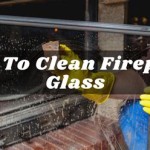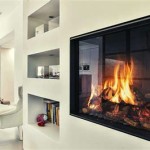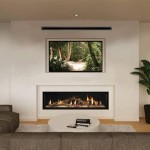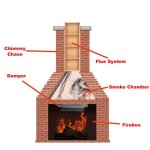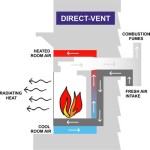Fireplace to Wood Stove Conversion: A Comprehensive Guide
Converting an existing fireplace into a functional wood stove offers several advantages, ranging from improved heating efficiency to enhanced aesthetic appeal. This process requires careful consideration of various factors, including local building codes, chimney integrity, stove selection, and installation procedures. This article provides a detailed overview of the key aspects involved in converting a fireplace to a wood stove, enabling a well-informed decision-making process.
One of the primary motivations for converting a fireplace to a wood stove is the significant increase in heating efficiency. Traditional open-hearth fireplaces are notoriously inefficient, often losing a large percentage of heat up the chimney. Wood stoves, on the other hand, are designed for controlled combustion and heat radiation, maximizing the amount of heat that is delivered into the living space. A properly installed wood stove can dramatically reduce heating costs, especially in regions with long and cold winters.
Beyond efficiency, wood stoves offer greater control over the burning process. Adjustable air intakes allow for precise regulation of the fire, enabling users to maintain a consistent temperature and optimize fuel consumption. This level of control is simply not achievable with an open fireplace, which is highly susceptible to drafts and fluctuations in air pressure. Furthermore, wood stoves typically burn wood more completely, resulting in less smoke and emissions compared to traditional fireplaces.
The conversion process involves several key steps, each of which requires careful planning and execution. From assessing the existing fireplace and chimney to selecting the appropriate stove and completing the installation, attention to detail is crucial to ensure a safe and effective conversion.
Assessing Existing Fireplace and Chimney
The first step in converting a fireplace to a wood stove is a thorough assessment of the existing fireplace and chimney. This assessment aims to determine the structural integrity of the fireplace, the condition of the chimney, and the compatibility of the existing infrastructure with the intended wood stove installation.
The fireplace itself should be inspected for cracks, damage, or deterioration. The firebox, the area where the fire is built, should be examined for any signs of structural weakness. The hearth, the non-combustible area in front of the fireplace, must also be inspected to ensure it meets the required dimensions for the chosen wood stove. Building codes typically specify minimum hearth extensions based on the stove's size and design.
The chimney is arguably the most critical component of the entire system. A damaged or improperly functioning chimney can lead to serious safety hazards, including carbon monoxide poisoning and chimney fires. A professional chimney sweep should be hired to inspect and clean the chimney before any conversion work begins. The inspector will assess the flue liner, the internal lining of the chimney, for cracks, deterioration, or obstructions. A properly functioning flue liner is essential for containing and safely venting combustion gases.
In many cases, the existing flue liner may be inadequate for use with a wood stove. Wood stoves typically require a smaller flue diameter than traditional fireplaces. If the existing flue is too large, it can lead to poor draft and increased creosote buildup. Creosote is a flammable byproduct of incomplete combustion that can accumulate in the chimney and pose a significant fire hazard. Installing a new, appropriately sized flue liner is often a necessary part of the conversion process. Common options include stainless steel liners and clay tile liners.
The height of the chimney is also an important consideration. Building codes typically specify minimum chimney heights to ensure adequate draft. The chimney should extend at least three feet above the highest point where it passes through the roof and at least two feet higher than any portion of the building within ten feet. Insufficient chimney height can result in poor draft, smoke backdrafting, and reduced stove efficiency.
Finally, the assessment should include a review of local building codes and regulations. These codes will specify requirements for clearances to combustible materials, hearth extensions, chimney construction, and stove installation. Compliance with these codes is essential for ensuring safety and avoiding potential legal issues.
Selecting an Appropriate Wood Stove
Choosing the right wood stove is crucial for achieving optimal heating performance and ensuring a safe and compliant installation. Several factors should be considered, including the size of the area to be heated, the desired heat output, the stove's efficiency rating, and the applicable emissions standards.
The size of the area to be heated is a primary determinant of the stove's required heat output. Wood stoves are typically rated in terms of British Thermal Units (BTUs) per hour. A larger area will require a stove with a higher BTU rating. It's important to select a stove that is appropriately sized for the space. An undersized stove will struggle to maintain a comfortable temperature, while an oversized stove can lead to overheating and inefficient operation.
The stove's efficiency rating indicates the percentage of energy from the wood that is converted into usable heat. Higher efficiency ratings generally translate into lower fuel consumption and reduced heating costs. Look for stoves that have been certified by the Environmental Protection Agency (EPA) and have a high efficiency rating.
EPA certification is another critical consideration. The EPA has established emissions standards for wood stoves to reduce air pollution. EPA-certified stoves are designed to burn wood more cleanly and efficiently, reducing smoke and emissions. These stoves typically incorporate advanced combustion technologies, such as secondary air systems, which promote more complete burning of the wood.
In addition to BTU rating and efficiency, consider the stove's design and features. Some stoves are designed for radiant heating, while others are designed for convective heating. Radiant stoves primarily heat objects in their direct line of sight, while convective stoves circulate warm air throughout the room. The best choice will depend on the specific heating needs and preferences.
The stove's firebox size and fuel loading capacity are also important considerations. A larger firebox will allow for longer burn times and less frequent refueling. Consider the size and type of wood that will be used and choose a stove that can accommodate the preferred fuel.
Finally, consider the stove's aesthetics. Wood stoves are available in a variety of styles and finishes. Choose a stove that complements the existing decor and enhances the aesthetic appeal of the living space.
Installation Procedures and Safety Considerations
Proper installation is paramount for ensuring the safe and efficient operation of a wood stove. Following the manufacturer's instructions and adhering to local building codes is essential for preventing potential hazards and maximizing the stove's performance. In many jurisdictions, a permit is required for installing a wood stove, and a professional inspection is necessary after the installation is complete.
The first step in the installation process is to prepare the fireplace opening and hearth. The fireplace opening may need to be modified to accommodate the stove's size and shape. Any combustible materials in close proximity to the stove must be removed or shielded with non-combustible materials. The hearth must be extended to meet the minimum requirements specified by building codes. The stove should be placed on a level, non-combustible surface.
Connecting the stove to the chimney is a critical step. As mentioned previously, a new flue liner may be required if the existing liner is inadequate or damaged. The flue liner should be properly sized for the stove and installed according to the manufacturer's instructions. The connection between the stove and the flue liner should be airtight to prevent smoke leakage. A stove pipe, typically made of black steel or stainless steel, is used to connect the stove to the flue liner.
Clearances to combustible materials are a major safety concern. Wood stoves generate significant heat, and it's essential to maintain adequate clearances to prevent fires. Building codes specify minimum clearances for walls, ceilings, and other combustible materials. These clearances may vary depending on the stove's design and the type of combustible material. Heat shields can be used to reduce clearances and protect combustible surfaces.
Proper ventilation is crucial for safe stove operation. Ensure that the room in which the stove is installed has adequate ventilation to prevent carbon monoxide buildup. Carbon monoxide is a colorless, odorless, and deadly gas that can be produced by incomplete combustion. Install carbon monoxide detectors in the home and test them regularly.
After the installation is complete, it's essential to test the stove to ensure that it is functioning properly. Start with a small fire and gradually increase the size of the fire. Monitor the stove's performance and check for any signs of smoke leakage or other problems. It's also important to familiarize oneself with the stove's operating instructions and safety precautions.
Regular maintenance is essential for maintaining the stove's efficiency and preventing safety hazards. The chimney should be inspected and cleaned annually by a qualified chimney sweep. The stove pipe should also be inspected regularly for corrosion or damage. Remove ashes from the stove regularly and dispose of them properly in a metal container with a tight-fitting lid. Never use flammable liquids to start a fire in the stove.
By carefully assessing the existing fireplace and chimney, selecting an appropriate wood stove, and following proper installation procedures, homeowners can successfully convert their fireplace into a highly efficient and aesthetically pleasing heating appliance. Prioritizing safety and adhering to local building codes will ensure a safe and enjoyable wood-burning experience.

Converting A Fireplace To Wood Burning Stove Chesneys

Pin On S

Converting A Fireplace To Wood Burning Stove Chesneys

Can You Convert A Gas Fireplace To Wood Burning Stove Direct Stoves

Converting Open Fire To A Wood Burning Stove In Exeter

Converting Your Fireplace Gas Or Wood Amarillo Tx West

Removing An Old Woodstove Fireplace Insert Young House Love

Should You Change Or Convert Your Wood Fireplace
Convert Freestanding Stove To Insert Hearth Com Forums Home

Wood Burner Conversion New Jersey Fireplaces Kjb
Related Posts


